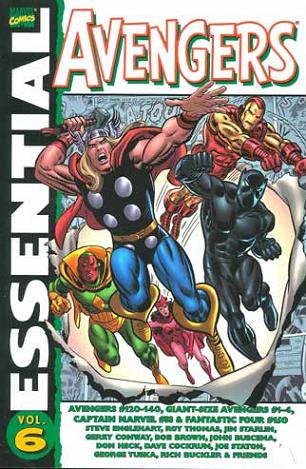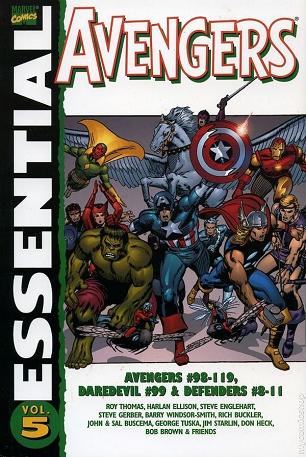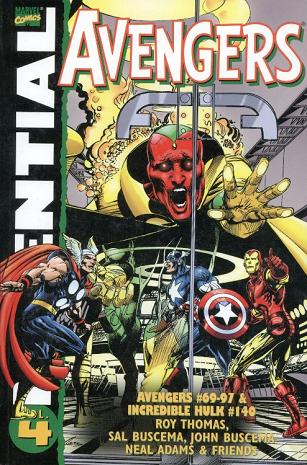
Essential Avengers Vol. 06
Steve Englehart, Sal Buscema, David Cockrum and friends
Reprints: AVengers #120-140, Giant-Size #1-4, Fantastic Four #150 Captain Marvel #33 (February 1974- October 1975)
Get this for: the Celestial Madonna — four stars
It’s probably a bit dim of me to only notice it now, but The Avengers after Lee had left was really a writer’s comic, wasn’t it? Sure, we remember Neal Adams doing the Kree-Skrull wars, or those couple of issues Barry Smith did, or John Buscema’s work, but if you look at it honestly The Avengers for long stretches at a time made do with good enough artists, all its pizzaz in its stories. In this volume, you got people like Rick Buckler, Bob Brown and Sal Buscema on the art, all doing a reasonable job, but never doing anything that stops you in your tracks. The writing on the other hand, which is all Steve Englehart (with some influence from Roy Thomas as editor), is doing its utmost to amaze and dazzle you. If it doesn’t quite succeed, this is not entirely its own fault, but as much due to the years that have passed since these stories were originally published. The style in which they were written has dated, not badly, but enough that they lose some of their impact. It feels overwritten, which was always Englehart’s weakness anyway, as it was of that whole generation of Stan Lee and Roy Thomas influenced Marvel writers.
Steve Englehart already got started on the epic stories in the previous collection, but here he goes all-out. Issue 129 to 135 and including Giant-Size Avengers #3-4 are one continuing story, the seeds of which were already sown half a dozen issues before. It is of course the saga of the Celestial Madonna, starring the Englehart created Mantis and featuring the Avengers, Kang, Rama Tut, Immortus, a host of long dead heroes and villains as the Legion of the Unliving, the Kree and their origin, the origin of the Vision and how he was related to the original Human Torch, why the Kree-Skrull war got started, the death of the Swordsman and the return of Hawkeye, who build the Blue Area on the Moon, the menace of Dormammu and the weddings of Mantis and the Swordsman, reanimated by an alien plantlike intelligence as well as the wedding of the Vision and the Scarlet Witch.
It’s a mess of a story, with a great many disparate elements dragged into it, but Englehart ties it all together beautifully. I had never read it before, knew about it, but never realised how much of what Englehart did here would influence The Avengers for decades to come. Englehart created the definitive Kang, clarified his relationship with Rama Tut and tied in old Avengers villain Immortus as well. He also provided a proper origin for the Vision, which must have been influenced by Roy Thomas considering its use of the original Human Torch, tying up a lot of old plot threads from The Fantastic Four and The Avengers and creating a new mess for others to “improve on”, or not. He also tied in the Avengers with wider Marvel mythology, with his use of the Kree and Skrulls as well as that mysterious blue area on the Moon that the Fantastic Four had found years ago.
On the whole The Avengers had never been so much at the heart of the Marvel Universe as under Englehart, participating in the Thanos War in a crossover with Captain Marvel, then crossing over with The Fantastic Four for the wedding of Crystal and Quicksilver. There’s also, in the last few issues collected here, the coming of the Beast to the Avengers, fresh from his own solo adventures and with plotlines continued from there. It’s the sort of continuity I grew up with from Marvel and the sort I like best, where there is always evidence of a wider universe beyond The Avengers, but out and out crossovers are rare and don’t last more than one or two issues.
As said, the art here is servicable to good, but you need to read this for the writing. Englehart would go on to do better work on other titles since he wrote the Celestial Madonna Saga, but this is perhaps his first great work.


